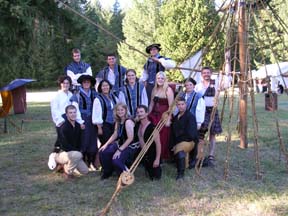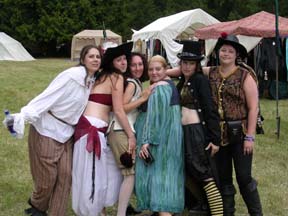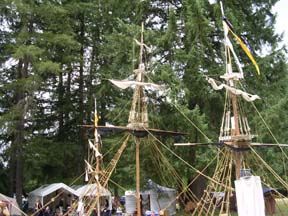|
Tarot Reflections |
|
October 01, 2003 |
|
Essay: Teaching
Tarot Reading Under Unusual Circumstances Christopher delaMaison, CPTR |
||||
|
Or, My Adventures at SeaDog Nights - Gypsy Carnival
A Tarot Reader's Tale
of Adventure on the High Seas Several years ago, long before I started reading tarot for public divination, I took up an interest in participating in a Middle Ages/Renaissance reenactment organization called the Society for Creative Anachronisms, or SCA for short. This organization, while international, holds several local events where the participants dress up in costumes ranging from 500 CE to 1650 CE, and participate in a wide range of events, from armored combat (with rattan weapons) to some serious Tablero tournaments (drinking games) running late into the evening. Having a history minor, this is one of the few organizations were I can indulge my taste for history and have the opportunity to wear my kilt, drum for belly dancers who are half my age, and work with my tarot cards. This year, the annual Seadog Nights – Gypsy Carnival event, held near Eugene, Oregon, was to be conducted as a fund-raiser for an SCA member who had become injured at an event in Washington State. As many folks in the SCA are either underemployed (some, but not much, money) or unemployed (little or no money), fund-raisers are becoming more common. Most SCA members will try to make at least a couple of these events each year. While now quite large, the SCA still has a close sense of community not found in many other organizations. This year’s event however, was of particular importance to me, as I was to hold a Tarot Reading class for the event participants. Now,
to prepare for a Tarot Reading class, I decided to put together a class
syllabus and some informational handouts. I was scheduled for two hours on
Saturday and possibly two hours on Sunday (depending on scheduled events),
which would limit my class to no more than an introductory look at Tarot
Reading. I assembled a short class outline, which included a few pages of
notes on card meanings and easy to learn card spreads. Once these were
printed out in quantity (as I didn’t know how many students would REALLY
show up), I set about collecting my gear and getting supplies for the
weekend. |
|||
|
In the SCA, I am a crewmember aboard the La Puta del Diablo, a Dutch privateer galleon; with a Spanish Captain, a Japanese navigator (Shogun in reverse), several Italian, English, and Irish officers and crewmen. I am the only Scotsman aboard this vessel, designated as the ship’s DO (Divination Officer). All crewmembers are expected to cook at least one meal, and help with other chores aboard ship. This includes setting up the masts and rigging, as needed. This is the entire ship’s company: officers, crew and guests. The Captain, Juan Ramirez del Santiago is in the center on the back row. To his right (with his arms crossed) is the First Officer, Andrew Crowe, and to his left (with his arm on the mainstay rope) is the Chief Quartermaster Gwydo StClaire. I am in the kilt, standing closest to the mast.
The event itself was held at a small farm northeast of Eugene, Oregon. In SCA terms, this area is known as the Barony of Adiantum. It is part of the Kingdom of An Tir, which includes Oregon, Washington, and part of British Columbia. At this event, the farm was converted into the seaside town of “Gypsy Cove.” The port itself consists of a string of palettes laid down, dividing the port into a dock where the ships were to tie up and the town. The town consisted of several vendor tents, each selling a variety of goods; just as any respectable pirate town would have. The inhabitants of “Gypsy Cove” included an assortment of colorful characters such as belly dancers, other “pirates,” in this case, the “Bodacious Pirate Babes,” as well as a number of ladies of “questionable” repute.
The ship I signed aboard is a square-rigged galleon, which sports three full-sized masts, complete with rope rigging, which we assembled during the weekend event. The rigging included functional dead-eyes and yardarms, each with its own functional running lines. All of the rope lines were cut from a rope bundle, with the ends whipped and hand-braided to prevent them from unraveling. The foremast (to the right of the picture) was 40 foot tall, the mainmast was 45 foot tall, and the mizzenmast was 37 foot tall. This was a lot of work, but the crew received a number of prizes for the most “authentic looking ship,” considering that this was all done in a farmer’s field. The white thing hanging from the foremast is the ship’s shower.
Once I had discharged my duties aboard ship, I set off to find my classroom and post as many signs as I could. Originally, my class was to be held on the small stage where the belly dancers would be holding their dance practice. This would have been an optimal location, as the stage was easy to find. However, as chance would have it, my class was relocated to the “Cross Road Learning Center,” which was a point in a wooded area where several paths formed an intersection. Now, this was not a bad place to hold a class, the woods provided ample shade and a very quiet place to hold a class. However, not everyone could find their way to this location. After waiting a few minutes, I decided to start the class with those folks who did manage to find their way in the woods. In the first two hours, we covered basic tarot history and deck structure, reading ethics, as well as introducing card definitions for both the major and minor arcane, which covered what information I wanted to present for the first portion of the class. We then spent an additional hour practicing one, two and three card spreads, as well as playing a tarot card game designed by Mary Greer, called Tarot Rummy, as a way to practice card meanings. At this point, I was convinced that everyone had probably had enough for the evening. We agreed to meet at this location Sunday morning, around 10:30 to finish up. I was sure Sunday morning class would only be an hour or two long, if that, as everyone had their own agendas, with things to do and people to see. Sunday morning, right at 10:30 AM, two of my three students showed up and were ready to start class. We spent just over two hours going over more advanced card spreads, from four up to seven cards, as well as touching on the Celtic Cross spread. Each student tried their hand at each type of card spread, as well as practice memorizing card meanings, by interpreting each others spread. I was surprised at how quickly these two student’s tarot skills were developing. After working with the Celtic Cross, I finished the morning with an overview of reader-client ethics (which included looking over the Code of Ethics for both the ATA and CTN), creating a personal code of ethics, and how to reword difficult client questions. By time we were finished, I noticed that it was after 2:30 PM, well into the afternoon. Although I had at most only three students, it seems that those few who were really interested made the effort to return and learn as much as they could from the class. In turn, I learned that I need to make sure I have enough information available to present, should my class run over its allotted time. Teaching a class outdoors on a summer day, in a quiet environment is always a treat. Even though the location was a bit out of the way, the trees provided a nice backdrop for a divination class. When I put this class together, I was a bit apprehensive, in that as a teacher, I am use to teaching very left-brain types of materials, such as computer and math courses. Teaching tarot reading, however, was a pleasant change of pace, especially with attentive students. From the student’s perspective, the more difficult parts of the class seemed to be getting a handle on the card meanings, and how to apply them in a reading. Starting with simple one, two and three card spreads helped get these students past this roadblock. Using Mary Greer’s Tarot Rummy game was also a big help in getting the students actively involved in memorizing card meanings, and expressing them in a simple reading.
Altogether, it was a fun class to teach. Having a pleasant location for
the class proved to be a big factor in the success of the students, and
also contributed to the extended times for both classes. Although I had
planned only two classes, at two hours each, it was refreshing to see that
folks were interested enough to stay an additional hour or two at the end
of each class. A more formalized setting would have required that I pay
better attention to my allotted time slots. However, as no one else was
using the classroom area (probably due to its location), there was no need
to hurry through the class material. This was an excellent way to spend a
weekend, and proved to be one of my better “shore leaves” in the SCA. |
||||
|
Subscribe to Tarot Reflections, and receive notification of each update! |
|
Request to be added to the list by sending email to TarotReflections-subscribe@yahoogroups.com! |
All articles remain the
property of their respective authors.
Tarot Reflections is a publication of the American Tarot Association
- Copyright (C) 2003
Questions or Comments? Contact Us.




